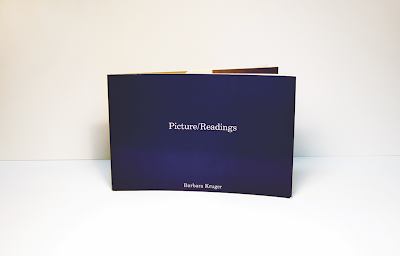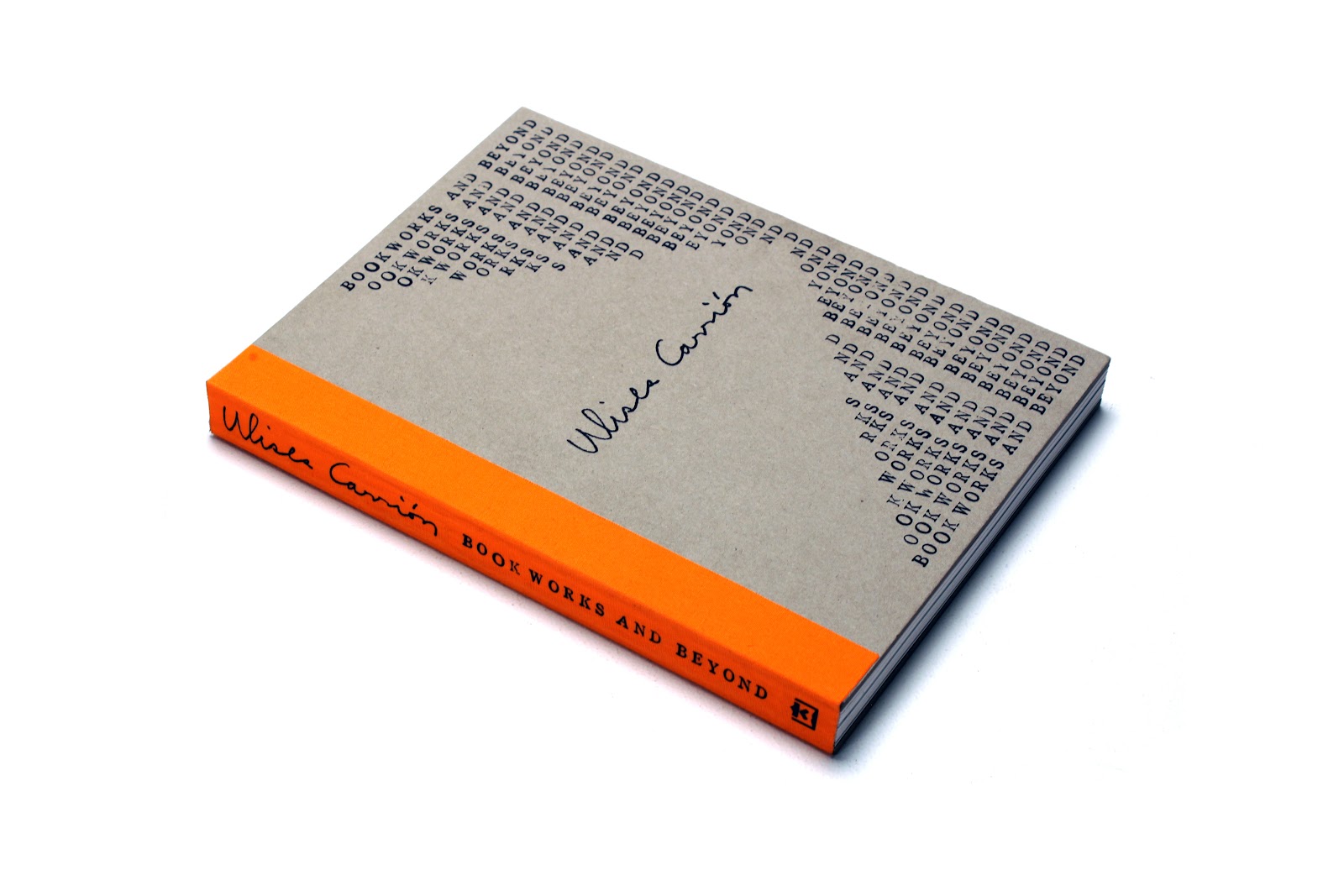Friday, July 26, 2024
Who Has Seen The Wind?
Merce Cunningham
Thursday, July 25, 2024
Primary Information Sale
David Shrigley | I Am The Jug You Are The Glass
Wednesday, July 24, 2024
Ness Lee | Connected, Here Together
Tuesday, July 23, 2024
Barbara Kruger | Picture/ Readings
Monday, July 22, 2024
Bob Watts | Male Underpants
Bob Watts | Female Underpants
Sunday, July 21, 2024
Goodwater Summer exhibition
Saturday, July 20, 2024
Ryan Gander | Time lost its meaning
Carole Condé and Karl Beveridge | ...It’s Still Privileged Art
Friday, July 19, 2024
The Fluxus Newspaper
Thursday, July 18, 2024
Miranda July | All Fours
Wednesday, July 17, 2024
Thomas Lélu | I have no idea what I’m doing out of bed
Tuesday, July 16, 2024
Lucy Lippard | Stuff
Monday, July 15, 2024
Ulises Carrión: Bookworks and Beyond
Published in February of this year, this impressive volume accompanies an exhibition of the same name, which is billed as the largest retrospective of Ulises Carrión's work in the US, fittingly held in a library, not a museum. Bookworks and Beyond examines Carrión's life and work through the lens of the Artist Book.
More broadly, it makes the case that Carrión’s practice involved a series of cultural strategies and the creation of networks that were foundational to his work: the artist as editor, publisher, fabricator, distributor, gallerist, bookseller, theorist, archivist and organizer.
Ulises Carrión was born in San Andres Tuxtla, Veracruz, Mexico in 1941. He studied philosophy and literature at the National University of Mexico, before receiving a grant to continue his studies at the Sorbonne in Paris, France. From there he went to the Goethe Institute in Achenmühle, Germany, and then to the University of Leeds, where he obtained a postgraduate degree with a dissertation on William Shakespeare titled Judas' Kiss and Shakespeare's "Henry VIII".
In 1972, he definitively settled in Amsterdam, a progressive and cosmopolitan city where he could live as an openly gay man. He co-founded (with Raúl Marroquín) the In-Out Center, the first independent artist-run centre in the city. Here he used a mimeograph machine to self-publish several artists' books under the imprint of In-Out Productions. The venue also hosted his first solo exhibition, Texts and Other Texts, in June of 1973.
The In-Out Center closed in 1974 and the following year Carrión opened Other Books and So, possibly the first centre dedicated to Artists’ Publications in Europe (Art Metropole in Toronto opened a year prior and Printed Matter in New York City a year after, in 1976).
In a short period of time, Other Books and So became “a key meeting point for practitioners engaged in mail art, artists’ books, and experimental writing and performance.” The basement bookstore/gallery - operated in collaboration with his lover Aart van Barneveld - advertised its wares as “other books, non books, anti-books, pseudo books, quasi books, concrete books, conceptual books, structural books, project books, plain books.”
As a gallery, it hosted over fifty exhibitions, including solo shows by artists such as Dick Higgins, Dorothy Iannone, Maurizio Nannucci, Allan Kaprow, Takako Saito, Anna Banana, and Jiri Valoch. Like Art Metropole, Other Books and So also published a magazine. Ephemera was a 12-issue periodical edited by Carrión, Barneveld, and Salvador Flores, focusing on Mail Art.
“By reimagining books as a sequence of spaces and temporalities, Carrión unmoored the book from its more conventional definition as a material support of texts and images” write the editors in the opening essay. They contextualize Carrión as starting out at a time when artists began employing text as an alternative to painting and sculpture, and when avant-garde writers started exploring the visual and sonic properties of poetry.
Monica de la Torre’s text “An Essay in Nine Books (and Not)” explores Carrión's work from his 1970 acclaimed collection of short stories De Alemania to the excellent 1979 Artist Book In Alphabetical Order.
This is followed by “Communities, Bureaucracy, and Office Technologies in Ulises Carrión’s Publishing Projects”, by Felipe Becerra. The text begins with Carrión’s disillusionment with Mail Art in the late seventies (which had devolved into goofy “Crackjack Kid” indulgences) and explores the typewriter, mimeograph and rubber stamp. But rather than merely celebrate these tools for their liberating DIY qualities, Becerra examines the clerical and bureaucratic connotations in works such as Sonnet[s] (1972) and Arguments (1973).
The essay also recounts the story of Carrión discovering a Beau Geste Press title in a bookstore in 1972, and writing to the publishers to learn more about their activities, leading to a lifelong friendship and collaboration.
“The Archive is Open” by co-editor Sal Hamerman follows, expanding the conversation from books to libraries and archives, as well as methods of distribution. Artists dedicated to the bookwork as a new form had to simultaneously consider ways to get these works into the hands of 'readers' and librarians.
When Other Books and So folded after three years, it was converted into an archive. Toronto’s Art Metropole developed an archive alongside their distribution activities, which eventually sold to a collector in the late nineties, who donated it to the National Gallery in Ottawa, where it remains accessible to researchers. Other artist-initiated archives from the era include Maurizio Nannucci’s Zona and Martha Wilson’s Franklin Furnace.
“Why should an artist open a gallery? Why should he keep an archive?”, Carrión wrote in 1985. “Because, I believe, art as a practice has been superseded by a more complex, more rigorous, and richer practice: culture. We’ve reached a privileged historical moment when keeping an archive can be an artwork.” Carrión felt an obligation to collect and preserve cultural artifacts, while avoiding the trappings of institutional libraries, museums and archives, which he characterized as “perfect cemeteries for books.”
Javier Rivero Ramos’ “The Most Illustrious Unknown Postmaster: The Erratic Networks of Ulises Carrión” applies Craig Saper’s notion of “intimate bureaucracies” to Carrión’s practice. Saper coined the term in 1997 to refer to systems which make "poetic use of the trappings of large bureaucratic systems and procedures to create intimate aesthetic situations, including the pleasures of sharing a special knowledge or a new language among a small network of participants.”
The final chapter in Ulises Carrión: Bookworks and Beyond is “Plural Authority as Queer Polyphony in Ulises Carrión’s Mail Art Projects” by Zanna Gilbert. Her essay investigates the artist’s interest in plagiarism and multi-authorship and also places his work in the context of other queer artists working with Mail Art, such as Dick Higgins and Ray Johnson (whose own work was not examined through the lens of his homosexuality until over twenty-five years after his death). She writes: “Carrión’s interest in plural authorship and artistic polyphony to create a community and queer the art world's systems was at the heart of this unusually trenchant engagement with mail art projects.”
Gilbert also gets at the Marxist underpinnings of the artist’s ideas, quoting Carrión from 1981:
“The organization of communication, and not the little thing that you send or the little thing that you make, nor the book that you make…is the next step, historically in art.” This notion perhaps best encapsulates Carrión’s wholistic approach to art production:
“Before you were a worker, now you’re the director of the factory.”
Ulises Carrión: Bookworks and Beyond is essential reading for anyone interested in "Mexico’s most important conceptual artist”, Artist Book theory, and artist-run bookstores. It is available from Printed Matter for $49.95 US, here.






















































